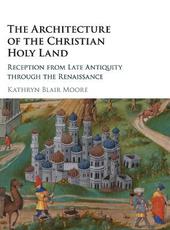
|
The Architecture of the Christian Holy Land: Reception from Late Antiquity through the Renaissance
Hardback
Main Details
| Title |
The Architecture of the Christian Holy Land: Reception from Late Antiquity through the Renaissance
|
| Authors and Contributors |
By (author) Kathryn Blair Moore
|
| Physical Properties |
| Format:Hardback | | Pages:436 | | Dimensions(mm): Height 287,Width 223 |
|
| Category/Genre | History of architecture
History of other lands
Archaeology
Archaeology by period and region
Biblical archaeology |
|---|
| ISBN/Barcode |
9781107139084
|
| Classifications | Dewey:720.95694 726.5095694 |
|---|
| Audience | | Professional & Vocational | | Tertiary Education (US: College) | |
|---|
| Illustrations |
22 Plates, color; 223 Halftones, black and white
|
|
Publishing Details |
| Publisher |
Cambridge University Press
|
| Imprint |
Cambridge University Press
|
| Publication Date |
27 February 2017 |
| Publication Country |
United Kingdom
|
Description
In the absence of the bodies of Christ and Mary, architecture took on a special representational role during the Christian Middle Ages, marking out sites associated with the bodily presence of the dominant figures of the religion. Throughout this period, buildings were reinterpreted in relation to the mediating role of textual and pictorial representations that shaped the pilgrimage experience across expansive geographies. In this study, Kathryn Blair Moore challenges fundamental ideas within architectural history regarding the origins and significance of European recreations of buildings in Jerusalem, Bethlehem, and Nazareth. From these conceptual foundations, she traces and re-interprets the significance of the architecture of the Holy Land within changing religious and political contexts, from the First Crusade and the emergence of the Franciscan Custody of the Holy Land to the anti-Islamic crusade movements of the Renaissance, as well as the Reformation.
Author Biography
Kathryn Blair Moore teaches medieval and Renaissance art history at Texas State University, San Marcos. She received her art historical training at the Institute of Fine Arts, New York University. Fellowships and grants from the American Council of Learned Societies, the American Academy in Rome, and the University of Hong Kong (where she previously taught) have supported extensive research throughout Europe, Western Asia, and North Africa. Her scholarly work explores the intersection of architectural, pictorial, and textual cultures, with a particular emphasis upon larger religious and political contexts, from pilgrimage to religious wars, that shaped the experience of buildings across Europe and the Mediterranean world.
Reviews'Most significantly, Moore focuses on the varying perceptions about these architectural landmarks over time and the ways they were visualized in different artistic media. Well written, including ample notes, and illustrated with images. Highly Recommended.' J. Pollini, Choice 'The book provides a first attempt at a general synthesis of a topic that was never discussed from a longue duree perspective. The author politely reacts against the tendency, still underlying many art-historical studies following a famous article by Richard Krautheimer, to consider all buildings that came to be described in medieval and early modern sources as inspired by or stemming directly from the Jerusalem Holy Sepulcher and other loca sancta churches as generic, symbolic, or basically inaccurate replicas of their archetypes.' Michele Bacci, The American Historical Review
|